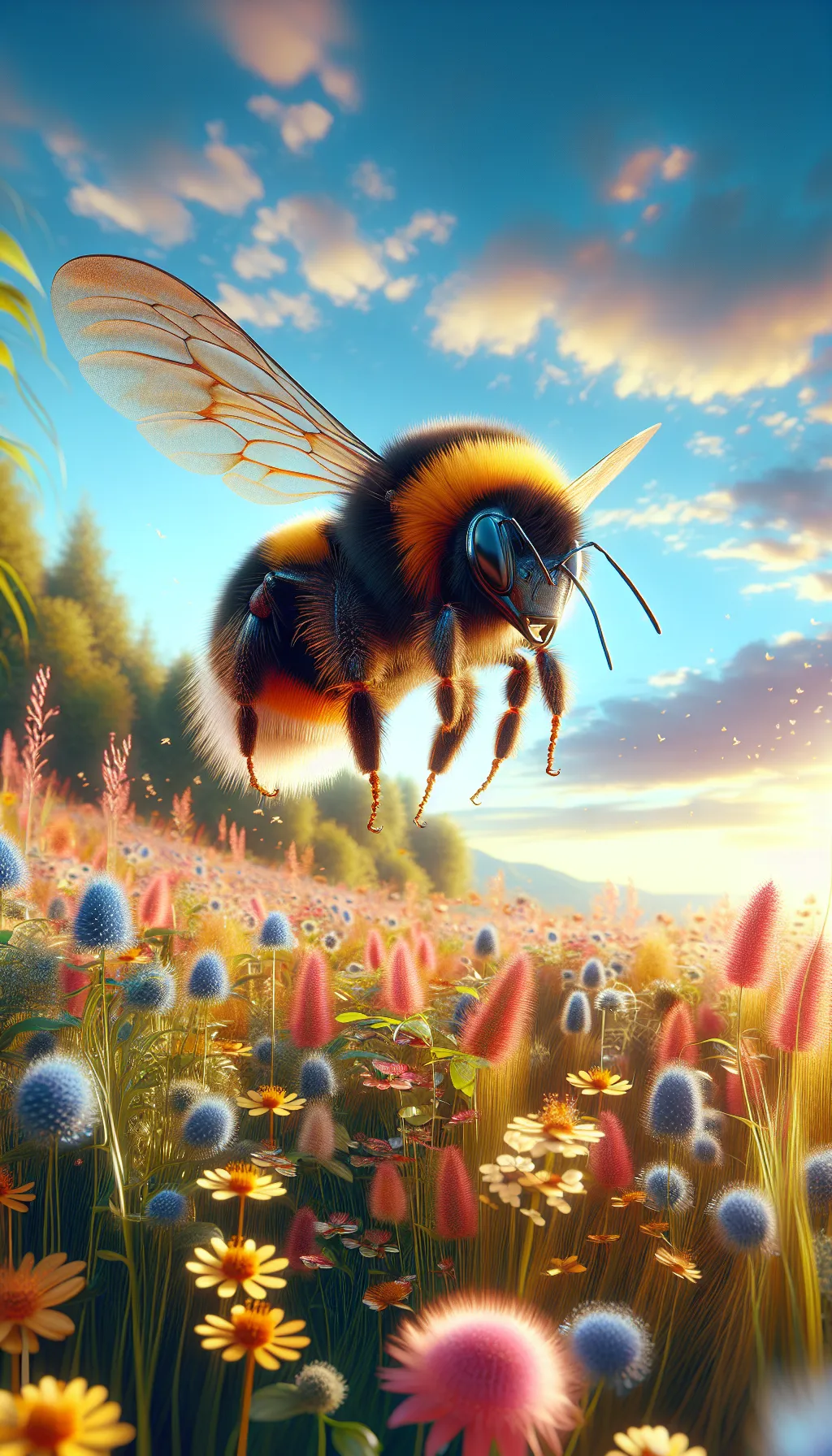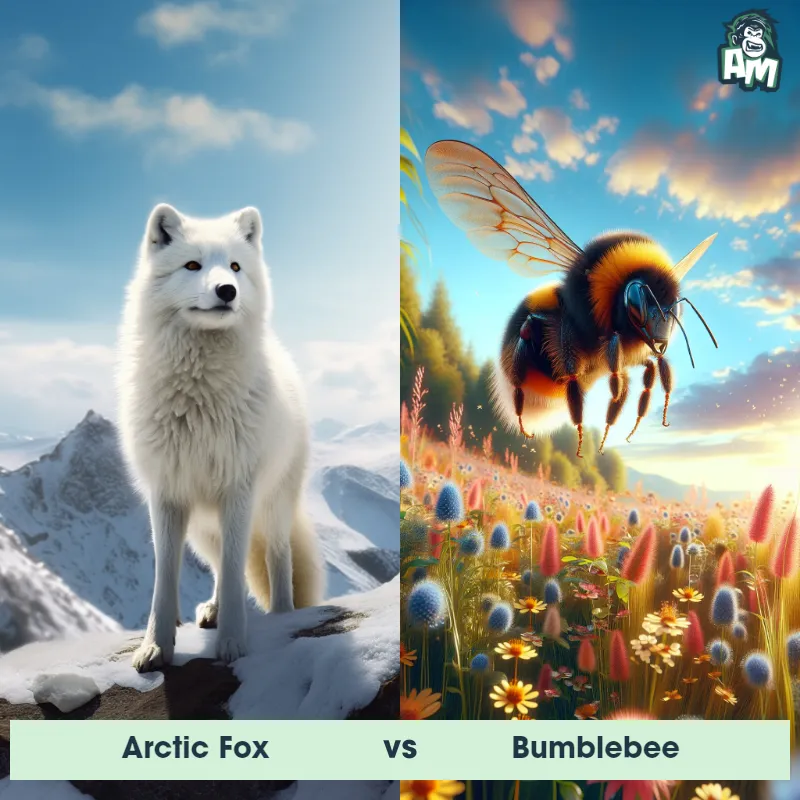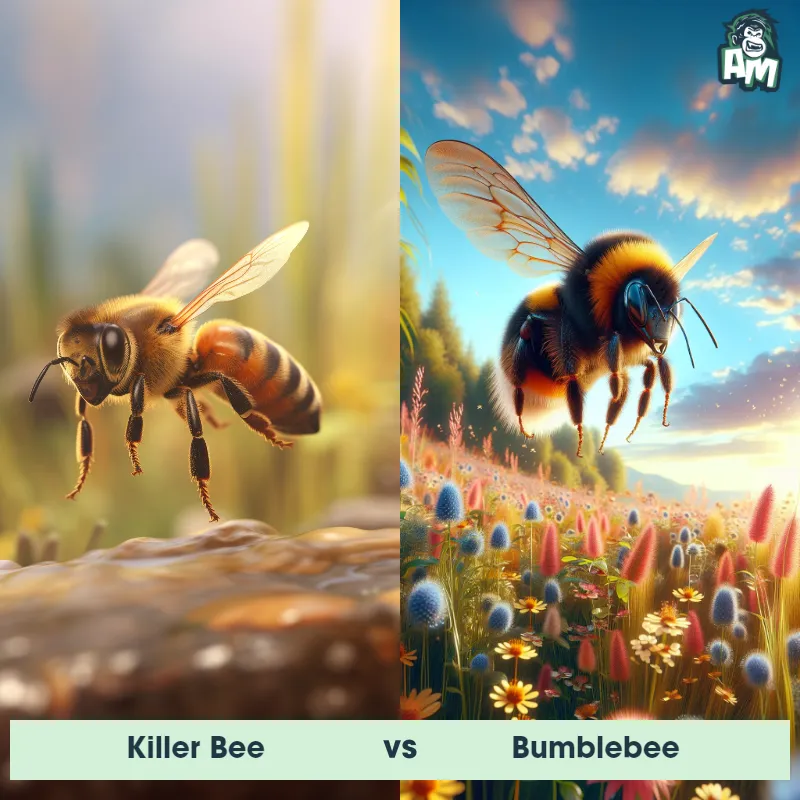The Bumblebee
The bumblebee is a type of flying insect that belongs to the Apidae family. They are known for their fuzzy bodies, which are covered in black and yellow stripes, and their large, round bodies. Bumblebees are important pollinators, and they can often be seen buzzing from flower to flower, collecting nectar and pollen. They have short, stubby wings and are capable of flying at high speeds. Bumblebees are social insects, living in colonies with a queen, workers, and drones. They build their nests in underground burrows or in abandoned rodent holes.

| Bumblebee | |
|---|---|
| Size | 0.4 to 1 inch (1 to 2.5 cm) |
| Weight | 0.07 to 0.18 ounces (2 to 5 grams) |
| Speed | 12mph (19km/h) |
| Key Strength | Agility and maneuverability in flight |
| Biggest Weakness | Vulnerability to predation due to their relatively large size and slower movement compared to certain predators |
| Scientific Name | Bombus |
| Family | Apidae |
| Habitat | Various habitats including forests, grasslands, gardens, and urban areas. |
| Geography | Found in North America, Europe, Asia, and some parts of Africa |
| Diet | Nectar and pollen from flowers |
| Lifespan | 1 months - 2 months |

The Bumblebee
The bumblebee is a type of flying insect that belongs to the Apidae family. They are known for their fuzzy bodies, which are covered in black and yellow stripes, and their large, round bodies. Bumblebees are important pollinators, and they can often be seen buzzing from flower to flower, collecting nectar and pollen. They have short, stubby wings and are capable of flying at high speeds. Bumblebees are social insects, living in colonies with a queen, workers, and drones. They build their nests in underground burrows or in abandoned rodent holes.
Fun Fact: Bumblebees are able to fly higher than most other insects, with some species reaching altitudes of over 10,000 feet!
| Bumblebee | |
|---|---|
| Size | 0.4 to 1 inch (1 to 2.5 cm) |
| Weight | 0.07 to 0.18 ounces (2 to 5 grams) |
| Speed | 12mph (19km/h) |
| Key Strength | Agility and maneuverability in flight |
| Biggest Weakness | Vulnerability to predation due to their relatively large size and slower movement compared to certain predators |
| Scientific Name | Bombus |
| Family | Apidae |
| Habitat | Various habitats including forests, grasslands, gardens, and urban areas. |
| Geography | Found in North America, Europe, Asia, and some parts of Africa |
| Diet | Nectar and pollen from flowers |
| Lifespan | 1 months - 2 months |
Bumblebee Matchups
We use AI to simulate matchups between the Bumblebee and other animals. Our simulation considers size, strength, and natural predatory behaviors to determine the most likely outcome.

Can't find the Matchup you want?
Create Your Own MatchupBumblebee: Diet, Predators, Aggression, and Defensive Behaviors
What do Bumblebees eat?
Bumblebees primarily feed on nectar and pollen from flowers. They have a long proboscis that allows them to reach deep into the flower to extract nectar. Pollen provides them with essential proteins and nutrients. Some bumblebee species also consume the pollen they collect to feed their larvae.
Do Bumblebees have any predators?
Yes, Bumblebees have various predators, including birds, spiders, certain insects like praying mantises, and some mammals. These predators often target bumblebees for their nutritious bodies or larvae. However, bumblebees have developed defensive mechanisms to protect themselves from these predators.
Are Bumblebees aggressive?
Bumblebees are typically not aggressive unless they feel threatened or their nest is disturbed. They are known to defend their nests vigorously, stinging intruders repeatedly if needed. Male bumblebees do not have stingers and are generally more docile than females.
Do Bumblebees fight?
While not known for engaging in physical fights with other bees or insects, bumblebees can exhibit territorial behavior and compete with other bumblebee colonies for food sources. These interactions may involve chasing away intruders or rivals from their territory.
How do Bumblebees defend themselves?
Bumblebees defend themselves primarily with their stingers. When feeling threatened, they can sting multiple times, injecting venom into their attacker. The venom contains a pheromone that signals other bees to join in the defense. Bumblebees also use mimicry to deter predators, resembling stinging insects like bees or wasps to ward off potential threats.
What is the biggest weakness of Bumblebees in a fight?
The biggest weakness of Bumblebees in a fight is their vulnerability to certain pesticide chemicals. Pesticides can have detrimental effects on bumblebee populations, weakening their ability to defend themselves against both prey and predators. Additionally, habitat loss and climate change have also posed significant threats to bumblebee populations worldwide.
Fun Fact: Unlike honeybees, bumblebees do not have barbed stingers, which means they are able to sting multiple times without dying.
Fun Fact: Bumblebees are excellent pollinators due to their unique method of extracting nectar. They use their strong jaws to bite a small hole in the flower, and then insert their long tongue, called a proboscis, to lap up the nectar. This behavior helps transfer pollen from one flower to another, aiding in plant reproduction.












